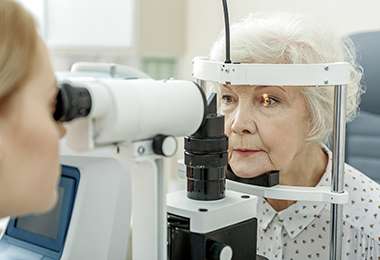
Intra-ocular laser procedures are common, safe and in most cases effective. Eye doctors have been performing these procedures for several years with positive results.
In-office laser eye surgeries for glaucoma, cornea disease, and retinal disorders are usually very comfortable. Patients most often may drive themselves home afterward.
This type of laser eye surgery is performed for chronic open-angle glaucoma. In 80% of patients, SLT will lower eye pressure and control glaucoma as well as eye drops. This laser causes no scarring, is usually quite painless, takes two or three minutes per eye, and can have lasting effects. Sometimes, one SLT treatment will control intraocular pressure (IOP) for a decade, and in some patients, the SLT may be repeated as often as six months.
Since this laser causes no scars, it can be used repeatedly, as long as it continues to help control pressure. Laser can be used in place of eye drops, or in addition to eye drops, and eye drops can be used in addition to laser as the individual case requires. Laser technique has been in worldwide use for nearly thirty (30) years, and SLT is the newest approach. (The previous laser–Argon–could not be repeated.)
A diode laser is used to treat the retina in diabetics who have leakage or seepage from diabetic eye disease. Diabetic eye disease is more common the longer someone has diabetes, and especially more common and severe in those with poor control of their diabetes. Different patterns of laser treatment are used for different types of diabetic eye disease. Overall, diffuse leakage might be treated with scatter laser. Small areas of leakage with an identified source of blood vessel leak might be treated directly with a “focal” laser to dry up the source.
Each diabetic case is unique and different, and only examination and evaluation of the findings can determine whether diabetic laser eye surgery is the best approach.
This treatment is performed in the office, is usually not painful, though it can be uncomfortable, and can last a few minutes for “focal” laser, to 10 or 15 minutes in some cases that need dense scatter laser treatment. The goal is to protect the vision from damage due to diabetic eye disease in the long term.
The diode laser is also used to treat retina holes and tears. This laser is also used to treat abnormal corneal blood vessels.
A secondary cataract, or after-cataract, does not mean that the cataract has returned. Cataracts never can form themselves again, because during cataract surgery, the actual lens material is removed from the eye. However, a clear capsule support for the implant usually remains. This capsule can develop haziness, or wrinkling; a YAG laser is used to rupture the hazy membrane, without affecting the implant. Patients usually return to normal activities and good vision within a few minutes to an hour. Only in cases of inflammation of the eye do these membranes ever return.
The YAG laser can also be used to form a peripheral iridotomy, which is a small perforation of the iris, or colored part of the eye. This will be necessary for a sub-category of glaucoma, “angle closure glaucoma”. This procedure is performed one eye at a time, usually, and takes a few minutes. In decades past, this narrow angle or angle closure disease required treatment in the operating room, which was a major, invasive procedure.
Great staff. Knowledgeable and competent doctors. Two loved ones have personal experience with 2 of the doctors – office visits, cataract surgery. We’re very pleased.